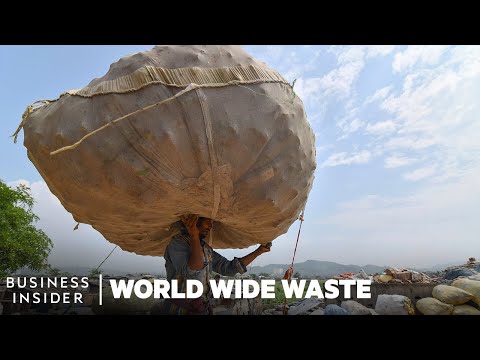How People Profit Off India’s Garbage | World Wide Waste | Business Insider

india generates more garbage than every country in the world besides china the government has taken steps to address all this waste including a ban on single-use plastics but across the country people are tackling the issue on their own from making tiles out of smog to filling teddy bears with old cigarette butts this is how india deals with worldwide waste these sneakers are made with garbage the company that makes them says each pair contains 10 plastic bags and 12 bottles [Music] for 110 they'll ship them anywhere in the world they clean the bags in a hot tub filled only with water without any added chemicals and then hang them out to dry inside the warehouse cyrudine stacks eight to ten layers of bags at a time didn't make them then places the pile under a heat press this finished product will cover most of the sneaker the company's founder calls it dailytex so it's a material that's made entirely out of base plastic bags without the use of any chemicals cyredine packs and ships them seven hours north to the natoch footwear factory that's where the shoe will be assembled first daily text sheets are die cut using metal forms other patterns are cut from our pet fabric which is made from recycled bottles and woven into something like canvas the workers stitch the two types of materials together the assembled upper gets stretched out daily soles are made with crumbs of industrial rubber a worker needs to rough the sole on this grinder so the glue added to the next step will adhere they coat the top of the sole with a clear glue a special uv light increases its stickiness the shoes go through a series of heat treatments and coats to strengthen the bond between the sole and the upper then comes the final round of stitching daley's laces are also made with recycled plastic india generates 3.5 million tons of plastic waste every year the idea behind chuck is to replace some of that plastic with biodegradable sugar cane waste india is the world's second largest producer of sugar making more than 25 million metric tons in 2020 and that means mountains of bagasse km sugar mill alone produces over 3 500 tons of it per day during the harvesting season it can be tough to work with [Music] most of this material will be burned to produce electricity it's a low pollution alternative to fossil fuels but it has other uses too we were told this is a very good fiber for molding for over 40 years veg krsna's family turned sugarcane waste into paper in a factory owned by his parents they named it yashpaka and their company slogan is packaging with the soul but the business ran into financial troubles and had to deal with faulty equipment we didn't know whether the company would run the next day or not what i realized was that all the work that i wanted to do was towards the ecology and environment ved went back to the drawing board he spent years experimenting with new ways to use bagas eventually we realized that you know we have sugarcane pulp and that can be molded into different products which can actually be used as placement for these styrofoam products and by 2017 the company was producing tableware products under a new brand chuck chuck was really good because of course it was about disposable you can chuck it it was also good with chak which is taste in hindi veg set up shop near sugar plantations and mills to keep costs and the carbon footprint low around 100 truckloads of bagasse arrive at the chuck factory every day during peak harvest season it can take two hours to unload each truck if the material dries out the fiber loses strength so we have to keep it in wet piles workers then remove a layer of the tiniest fibers before washing and pressure cooking it same concept as you cook dal in your home the same way you cook bagas you use a certain alkaline product to be able to remove the stickies you know if you think of a sugary product it's a little sticky the alkaline solution helps make it moldable workers wash the sludge again to remove any residual chemicals then they distribute it into different machines and molds that press it into shape squeezing out all the water other companies bleach their products but chuck decided against it we were told in the market indians don't like to eat in brown it has to be white but i said no if we are true to our basic idea that we want to be more ecologically sustainable then we have to stay with lesser and lesser chemicals chuck also sources a starch-based compostable packaging for its products instead of virgin plastic we of course realize that our whole ecosystem dna world revolves around the idea of leaving the earth cleaner so if that is the case and we package in plastic then we've defeated the purpose workers like shilwati check the finished products for quality before counting and packaging the chuck factory can crank out one million individual items in a day increasingly waste ends up in india's largest rivers considered sacred by hindus every day millions of worshippers offer flowers to their gods now one company turns that flower waste into incense sticks it all starts in bustling wholesale markets like the one in chivalea merchants pick up the flowers that they'll sell outside hindu temples [Music] because these flowers are used in rituals they're considered sacred and can't be thrown into the garbage every day more than a thousand tons of flowers end up in the ganges river but many contain toxic chemicals like arsenic lead and cadmium as well as pesticides i have been seeing people putting flowers in the water all my life but never before had anyone questioned temple waste as a source of pollution the seed was sown ankit founded fool which is the hindi word for flower the company's employees pick up the waste from temples throughout kanpur making around 19 stops a day then they transport the flowers to fool's facility where they weigh and separate them from thread fabric and plastic save only the flower petals for the incense sticks and sort them by color they keep the buds and stems to create compost that is sold as a separate product then they lay the flower petals out to dry on large tarps [Music] once they're dry they grind them into a powder that is mixed by hand with water and essential oils until it reaches a clay-like texture [Music] then it's time to roll workers dip their fingers into the flower powder while rolling to create an even thickness then they let the sticks dry before dipping them again in essential oils they're laid out to dry one more time then packaged up workers here can produce around 400 incense sticks every hour ankit calls this transformation flower cycling and he says his product is cleaner than others normally insane sticks are made from charcoal burning charcoal releases the poisonous sulphur dioxide and gives out a lot of xylene chemicals in other parts of the country people have figured out a way to deal with another type of organic waste vegetables 10 tons of food goes unsold every day at this market but instead of going to a landfill it's turned into electricity that will power street lights buildings and a kitchen that preps meals for 800 people this is called biogas it's plentiful it's low tech and experts say it burns cleaner than any fossil fuel so why can't we make energy from the 1.3 billion tons of food that gets thrown out every year we visited the bon pali market in hyderabad india to find out the first step is to chop up larger vegetables and load them onto a conveyor belt some of the vegetables are spoiled others are thrown away because it costs farmers too much to transport them back home the conveyor belt carries the material to a shredder which further breaks down the food into smaller more uniform particles in a single day it handles the same amount of vegetables that 150 indians eat in a year a grinder crushes the mixture into pulp which is pumped through underground tanks and into two digesters so anaerobic digesters basically have a bacteria which are operated in the absence of oxygen or anaerobic bacteria and they actually eat essentially the food waste that we are putting in there and give out methane and carbon dioxide any organic materials emit these planet warming gases as they decompose but the massive amount of food waste makes landfills the third largest source of human-caused methane emissions just behind fossil fuels and agriculture burning biogas to make electricity is a way to harvest those gases before they enter the atmosphere at bowen poly the fuel can be stored locally in four huge balloons until it's ready to use and it goes all the way to the kitchen which is about roughly 400 500 meters away from here it's enough power to run a canteen kitchen that serves roughly 800 meals per day in overcrowded cities like delhi plumbing constantly breaks this man is diving into a sewer filled with toxic waste to unclog pipes [Music] it's one of the deadliest jobs in all of south asia in india permeshwar kumar has been doing this job for 36 years this kind of work is technically illegal here but many say they have no other options he gets ready for work and prays to the gods he gathers his tools and heads out for the day he already has a list of customers who need his services [Music] today's drain is trickier because the government has sealed off the sewer entrance so he has to hammer through the cement to reach the blockage [Music] if he can't reach it with the bamboo stick or metal rod he has to climb down himself that's the most dangerous part of his day a lot can go wrong when he's down there or music foreign plastic bags hair and anything else that's thrown down the drains can get stuck in the pipes more than 5 000 miles of sewer lines stretch across the capital and surrounding areas they're poorly maintained and falling apart because it's so dangerous the indian government banned this kind of work in 2013 but it's still happening today [Music] research has shown that 80 percent of indian sewage workers die before the age of 60 because of health problems one time per meshware thought he would be next he got stuck inside of a clogged pipe okay [Music] skin is also fully exposed he doesn't wear much to protect himself because he can't afford it [Music] he used to work for the government but it didn't pay well so nowadays he relies on referrals foreign he gets about five jobs a month bringing in 12 000 rupees that's about 150 dollars [Music] but sewer workers may not have the dirtiest job in india [Music] around 75 000 people known in india as rag pickers make their living in delhi's dumps the average rag picker earns 200 to 300 rupees a day about three to four dollars with plastic and metal being the most valuable items collected even when they're not on fire the landfills pose major health risks has been treating patients who work at the boswell landfill for over 20 years doesn't have a proper drainage system so runoff from the landfill makes its way into the ground water so [Music] scientists use the air quality index or aqi to measure air pollution and india has one of the worst measures in the world one study said air pollution led to more than 1.6 million premature deaths in 2019.
then there's the odor moving not to mention the everyday dangers india has some of the most unhealthy air in the world so how did india's air quality get so bad it starts at home where many cook with wood and dung both create a lot of smoke and then there's traffic the number of vehicles on the road has more than quadrupled since 2003. pollution is worst at the onset of winter that's when farmers burn agricultural waste diseases triggered by air pollution kill over 1 million people in india every year that's 10 to 20 times higher than the rate in the united states the good news is that black carbon is short-lived it only stays in the air for a few weeks it's not like carbon dioxide an invisible gas that can warm the atmosphere for centuries the problem is that people in india burn so much stuff the air never has time to clear so preventing black carbon from getting up there in the first place could make a difference that's the big idea for tejas signal an architect and the inventor of carbon tiles this carbon is what is in your lungs and my lungs right now i'll show you around how our office looks like and what we do he launched carbon craft design in 2020 to create marketable products that upcycle waste tagis sources most of the carbon from companies that would otherwise release it into the atmosphere like this facility that recycles tires the factory produces loads of black carbon that usually gets sold as cheap fuel but when that gets burned it puts the pollution back into the atmosphere carbon craft interrupts this cycle and puts the toxic powder in its tiles it comes in these huge sacks dry and absolutely pitch black the sacks go to a factory that has been making tiles by hand for 35 years many mass-produced tiles only harden in kilns burning at high temperatures but carbon tiles made from cement are never baked so the process doesn't require a lot of energy this is also the lowest carbon footprint way of making a tile we thought why don't we adopt this tages places an order whenever he secures a new customer the workers follow a process that's been around for over 200 years now they replace some ingredients with black carbon [Music] carbon zero once the powder reaches a smooth consistency they mix it with water to create a slurry the amount of black carbon in the mix determines the shade of the cement [Music] it takes skill to get the consistency right too much water and the tile won't hold together too little can ruin the pattern every design has its own metal stencil workers pour the slurry into the voids one of the hardest parts is to get crisp lines so workers have to move quickly remove that stencil at a flick so that it doesn't have a distorted design and then they add the backing layer that also has carbon the first layer is more for the aesthetics and the pattern that really comes out the back layer is for strength the factory's only hydraulic press squeezes the tile into shape and helps it set for punch hydraulic press method the firmed up tiles still need to strengthen through a process called water curing that means they get hosed down every day for nearly a month workers give the fully cured tiles a rough polish and a final rinse before they get packaged for sale all carbon tiles are made to order the company says it can make as many as 200 of them in a day the cost of one tile is less than two dollars that's comparable in price to cement tiles that don't contain carbon the biggest order we've had is about 100 square feet carbon craft has only done about 10 installations across india in the past year they consider these pilot projects at the moment we are working with a lot of architects interior designers who are keen to solve this larger problem of air pollution like manan a general contractor in mumbai so these are the carbon tiles that we've installed in my room basic 8x8 slabs in plain gray color this was the first time they've ever been installed anywhere in the world but installation is tricky cement tiles require a lot of extra polishing even after they're put in place so it could range anywhere between three to four sets of the whole process which is about say 15 to 20 odd days other mass produced tiles that harden under high heat skip this part but manan's business partner says the benefits to the environment outweigh the drawbacks he's happy with the results and recommends the tiles to clients and it is something very small that we're doing right now but you know it can have a big impact if we put it on a larger scale and despite india's unhealthy air many people still regularly smoke these cigarette butts are being turned into teddy bear stuffing every year people toss the ends of 4.5 trillion cigarettes they often think the filters are just biodegradable cotton no big deal but what they actually are is a small hunk of plastic infused with formaldehyde nicotine and tons of other chemicals now one company has figured out a way to stuff used butts into well toys it also makes cushions and mosquito repellent could this model hold the solution for literally the most littered thing on earth and even if it's getting butts off of the streets and out of the waterways how safe is it we went to a city called noida in northern india to find out workers here screen almost 7 million cigarette butts with a metal detector every month the super scanner is used to detect if the material has any metal items or anything that is illegal or that can harm our team members a network of hundreds of people collect butts off the streets of noida a company called code effort pays them about 300 rupees per kilo that's just over four dollars code effort delivers the waste to the homes of contractors where they pull apart the filters paper and tobacco they hand off the tobacco to nearby farms to be composted the paper gets dumped into this industrial grinder and treated with an organic binder the sheets dry out in the sun then get cut packaged and sold online or in local shops the paper and remaining nicotine act as a mosquito repellent when burned for the mosquito repellents we have a brand name nmos that is an abbreviation for no mosquito to use it you just have to burn it from one end the company is introducing scented versions sometime in the next year the plastic fibers from the filters go into the same grinder they are then soaked in sterilizing chemicals for 24 hours which leaves them looking like cotton the chemical mixture is a company secret but the processes involved in recycling the butts have been independently certified as safe and this is the last stage where the cotton is fluffed and carded into the prescribed form and this is helpful to ensure that the final products like soft toys cushions and keychains are very soft and comfortable all these products are sold online and offline through various mediums [Music] you
2022-07-30 15:07


